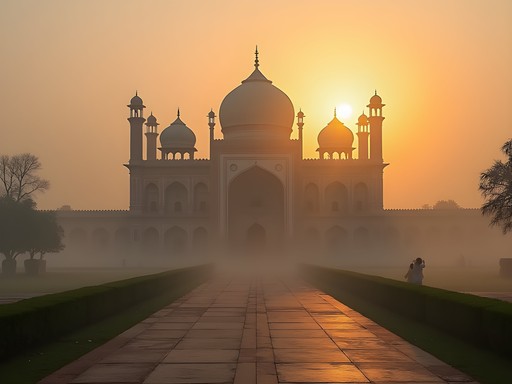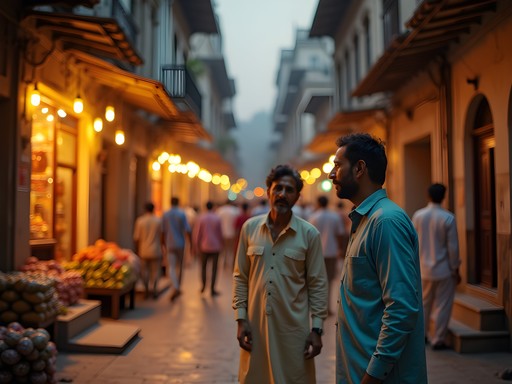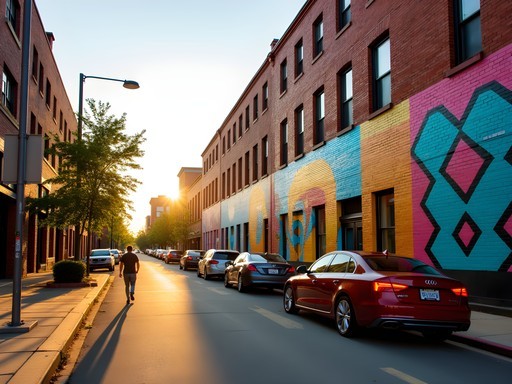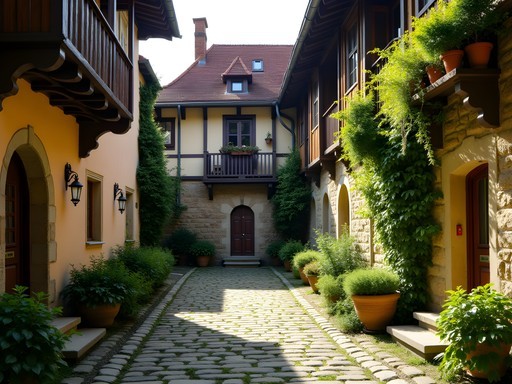Disclosure: This article contains affiliate links. We may earn a commission from purchases at no extra cost to you, which helps our travel content.
The morning fog hung like a velvet curtain over Lucknow's skyline, revealing only snippets of the architectural treasures waiting to be discovered. Like a slow jazz melody building to its crescendo, this city unwraps its secrets one layer at a time. As a former meteorology student with an obsession for how weather shapes cultural landscapes, I found Lucknow to be the perfect storm of historical preservation and atmospheric wonder. The winter air here carries whispers of the Nawabs who once ruled these streets, their legacy etched in stone and waiting for the right explorer to find them.
When Weather and History Collide: Why Winter in Lucknow Hits Different
Let me drop some meteorological truth: Lucknow in winter is atmospheric perfection. Temperatures hover between 5-20°C (41-68°F), creating that magical sweet spot where you can explore for hours without melting into the pavement or freezing solid. The morning mist creates a cinematic filter that makes even amateur photographers look like they know what they're doing.
But here's the real kicker—winter brings dramatically fewer tourists. While summer sees the major sites packed tighter than a Mumbai local train, winter lets you wander the Bara Imambara without photobombing twenty selfie sticks. I spent an entire hour alone in the labyrinth of the Bhulbhulaiya (the famous maze), with only the echoes of my footsteps for company.
For capturing these misty morning moments, I relied heavily on my weather-resistant notebook to jot down observations without the pages turning to mush in the humidity. Trust me, when you're sketching architectural details while perched on centuries-old steps, regular paper just doesn't cut it.

💡 Pro Tips
- Visit major sites before 9 AM to catch the mystical morning fog effect
- Bring layers—mornings can be surprisingly chilly but afternoons warm up nicely
- Book accommodations with heating options, as nights can drop to 5°C/41°F
The Forgotten Rhythms of Nawabi Architecture
Every city has its greatest hits—those landmarks that make it onto postcards and Instagram feeds. But Lucknow's B-sides are where the real magic happens. While tourists flock to Bara Imambara (which, don't get me wrong, is spectacular), I found myself drawn to the lesser-known architectural compositions.
The Dilkusha Kothi ruins hit me like an unexpected key change in a familiar song. Once a hunting lodge for the Nawabs, it now stands partially destroyed—a casualty of the 1857 uprising. The British cannonballs still embedded in its walls tell stories that no tour guide script could capture. I arrived at sunset when the low winter light cast long shadows across the crumbling facades, creating a natural light show that would make any music festival lighting designer jealous.
Nearby, the Maqbara Bibiapur offers a haunting melody of Indo-Islamic architecture without the crowds. I spent an afternoon sketching its intricate jali work while a local chai vendor kept me fueled with masala tea that could warm you faster than any thermal flask (though I was glad to have mine for the early morning explorations).
For navigating between these scattered sites, I relied on my offline maps app since many of these places don't appear on standard tourist maps and internet connectivity can be as unpredictable as monsoon patterns.

💡 Pro Tips
- Visit Dilkusha Kothi near sunset for dramatic lighting on the ruins
- Bring small denominations of cash for entrance fees at lesser-known sites
- Learn basic Urdu phrases—locals appreciate the effort and often share hidden spots
Nawabi Acoustics: Where Architecture Meets Sound
As someone obsessed with both weather patterns and music festivals, Lucknow delivered an unexpected mashup of my passions through its acoustic architecture. The Nawabs weren't just building pretty structures—they were crafting sonic experiences that would make modern sound engineers jealous.
Case in point: the whispering gallery at Gol Gumbaz. Stand at one end of this dome and whisper—your voice travels clearly to someone standing at the opposite end, nearly 40 meters away. It's like the 18th-century version of a perfectly tuned concert hall. I spent hours testing different tones and sounds, much to the amusement of the lone security guard who eventually joined in my acoustic experiments.
The Husainabad Clock Tower area transforms completely based on weather conditions. On foggy mornings, sound seems to hang in the air, creating an ethereal acoustic blanket. But on clear, dry winter afternoons, the same space becomes sharply resonant. To capture these acoustic differences, I used my portable audio recorder which has become as essential to my travels as my weather thermometer.
For the full sensory experience, time your visit to the Rumi Darwaza when the muezzin calls for prayer from nearby mosques. The sound waves interact with the architecture in ways that no digital sound system could ever replicate—it's the original surround sound, designed centuries before Dolby figured it out.

💡 Pro Tips
- Visit Gol Gumbaz early morning when fewer people are around to test its acoustic properties
- Bring a small musical instrument like a harmonica to experience different acoustic spaces
- Record ambient sounds at different times of day—the city's soundscape changes dramatically with weather conditions
Student Budget Hacks: Nawabi Experiences Without Royal Expenses
Let's talk rupees and sense. Lucknow delivers champagne experiences on a chai budget if you know where to look. As someone who retired at 25 through aggressive saving, I'm all about maximizing experiences while minimizing expenses.
Accommodation first: skip the tourist zones and head to Hazratganj or Gomti Nagar where local guesthouses offer rooms for ₹800-1200 ($10-15) per night. I stayed at Homestay Lucknow near Hazratganj, where the owner not only provided a clean room with heating (crucial in winter) but also mapped out an entire architectural tour no guidebook would mention.
For food, the city that invented Tunday Kebabs and Awadhi Biryani doesn't need fancy restaurants to deliver flavor thunderstorms. The narrow lanes of Chowk area house century-old establishments where ₹150 ($2) gets you a meal fit for the Nawabs themselves. My weather-tracking app showed a cold front moving in, so I warmed up with Lucknow's famous Nihari stew at Raheem's—a place that's been perfecting the same recipe since 1890.
Transportation can drain your budget faster than a summer cloudburst. Ditch the auto-rickshaws that charge tourist prices and download the local transit app to navigate Lucknow's surprisingly efficient bus system. A day pass costs just ₹60 (less than $1) and covers most architectural sites.
For staying hydrated while exploring, I relied on my trusty water purifier bottle which saved me from buying countless plastic bottles and worked perfectly with Lucknow's tap water.

💡 Pro Tips
- Use the City Heritage Walk app (free) for self-guided tours instead of paying guides
- Visit major sites on weekdays when student discounts are more readily available
- Carry a student ID for half-price entry at most monuments (even international student IDs work)
Weather-Watching: Lucknow Through a Meteorologist's Eyes
My meteorology background has turned me into a human barometer of sorts, and Lucknow's winter microclimate is fascinating enough to make me dust off my old weather journals. The city sits in the Indo-Gangetic plain, creating unique atmospheric conditions that directly impact how you should plan your architectural explorations.
The Gomti River creates a fascinating temperature gradient across the city. Northern monuments like Residency experience morning fog that burns off by 10 AM, while southern sites near Dilkusha might remain misty until noon. I tracked these patterns using my pocket weather meter and planned my photography accordingly.
The real meteorological magic happens during temperature inversions—when cold air gets trapped beneath warmer air above. This creates a stunning effect where mist hovers at a specific height, often cutting buildings in half visually. The British Residency ruins look particularly otherworldly during these events, like ghost buildings emerging from clouds.
For photographers, these conditions create natural diffusion that softens harsh shadows and makes architectural details pop. But timing is everything—I found the perfect conditions typically occurred between 6:30-8:30 AM, with secondary opportunities around 5 PM as temperatures began dropping again.
To protect my camera gear from the dramatic humidity swings (from foggy mornings to dry afternoons), I kept my equipment in a humidity-controlled camera bag when not in use. Nothing kills exploration momentum faster than fogged-up lenses when that perfect architectural shot presents itself.

💡 Pro Tips
- Track sunrise times—they're later in winter (around 7 AM), giving you extra sleep without missing golden hour
- Bring a microfiber cloth to wipe condensation from camera lenses during humidity changes
- Use the AccuWeather app specifically for Lucknow—it's surprisingly accurate for predicting morning fog conditions
Final Thoughts
As my week in Lucknow drew to a close, I found myself sitting atop the Satkhanda Tower watching the winter sun set over a city that feels like it exists in multiple centuries simultaneously. The weather patterns that drew me here as a meteorology enthusiast had revealed architectural treasures that few tourists ever witness. The rhythm of Lucknow isn't found in travel brochures—it's in the morning mist swirling around forgotten monuments, in the acoustic perfection of ancient domes, and in the temperature gradients that paint the city in constantly shifting light.
For students and budget travelers willing to embrace winter's embrace, Lucknow offers a masterclass in architectural exploration without the crowds or costs of India's more famous destinations. Pack your layers, bring your curiosity, and let the forgotten melodies of the Nawabi era become the soundtrack to your own exploration. As we say in meteorology, sometimes the most beautiful patterns emerge from unexpected convergences—and in Lucknow, history and weather collide in perfect harmony. I'll be back when the monsoon creates yet another atmospheric canvas for these timeless structures.
✨ Key Takeaways
- Winter provides the best atmospheric conditions for exploring and photographing Lucknow's architecture
- Lesser-known sites like Dilkusha Kothi and Maqbara Bibiapur offer profound historical experiences without crowds
- Budget travelers can experience Nawabi luxury for under $25/day with strategic planning
- Morning temperature inversions create unique photographic opportunities between 6:30-8:30 AM
- The acoustic properties of Nawabi architecture are best experienced during quieter winter months
📋 Practical Information
Best Time to Visit
December-February
Budget Estimate
$20-30 per day for budget travelers
Recommended Duration
5-7 days
Difficulty Level
Intermediate
















Comments
globebuddy
Those photos of the misty architecture are absolutely stunning! Adding Lucknow to my bucket list right now!
Landon Ortiz
Thanks! Shot most of them during the golden hour with just my phone camera. The light in Lucknow does all the work!
globebuddy
No way that's just phone photography! What settings did you use?
Sage Dixon
Landon, this post is EXACTLY what I needed! I'm planning a North India architecture tour and was debating whether to give Lucknow more than 2 days. Now I'm extending to 5! That section on 'Nawabi Acoustics' particularly caught my attention - I've been fascinated by how ancient architects designed spaces for sound. Did you happen to visit during any musical performances? I've heard the acoustics at Bara Imambara are incredible during qawwali sessions. For anyone planning winter visits, I'd add that a good pair of layers is essential. The mornings can be surprisingly chilly, especially if you're out catching that gorgeous fog in photographs. I use my merino base layer which packs tiny but keeps me warm during those sunrise photo sessions!
hikingchamp
Love the section on budget hacks! How safe is it for solo travelers to wander around these lesser-known spots? Planning a trip in January.
Landon Ortiz
Very safe in my experience! The locals are incredibly helpful. For the more remote sites, I'd recommend going during daylight hours. January is perfect - the winter light makes for amazing photos!
wanderqueen
This brought back so many memories! I visited Lucknow last winter and totally agree about that special fog that makes everything look magical. Spent hours at Bara Imambara just staring at the ceiling details. Did you make it to any of the smaller imambaras? There's one hidden behind some shops that barely any tourists visit but the caretaker will give you a personal tour for just 100 rupees!
Sage Dixon
Which hidden imambara was that? I'm heading to Lucknow in December and would love to check it out!
wanderqueen
It's called Zainab Bibi ka Imambara! Hard to find but worth it. Ask locals near Chowk market and they'll point you in the right direction.
Claire Hawkins
Landon, your post brought back so many memories! I took my family to Lucknow last winter, and my kids were absolutely enchanted by the 'secret passages' of Bhool Bhulaiya. What surprised me most was how family-friendly these historical sites were - my 8-year-old became obsessed with the architectural details and spent the whole trip sketching the jharokhas and arches in her little notebook! One tip for families I'd add to your budget hacks: many of the smaller sites offer significant discounts for children under 12, and some even have special guided tours designed for kids that explain the history through stories and legends. The storytelling session at Chota Imambara had my children completely mesmerized - they still talk about the 'whispering domes' months later! Did you happen to visit during any of the winter cultural festivals? We caught a classical music performance at Residency ruins that was absolutely magical with the fog rolling in.
starlife
I grew up in Lucknow and it's so refreshing to see someone appreciate the hidden details most tourists miss. The section on Nawabi acoustics brought back childhood memories of playing in these spaces. If you ever return, check out Firangi Mahal - it's not on tourist maps but has some beautiful architectural elements and an interesting history connecting Islamic and Western scholarly traditions.
adventuremate
Thanks for the Firangi Mahal tip! Adding it to my list for my return trip next year.
greendiver
This is exactly the kind of hidden gem content I follow travel blogs for! I'm a student planning to visit India next year and Lucknow wasn't on my radar until now. How many days would you recommend to explore these lesser-known sites? And did you feel safe wandering around the older areas? The budget hacks section is super helpful btw!
exploreadventurer
Not the author but I spent 3 days in Lucknow last year and wished I had at least 2 more. The old city areas are generally safe during the day, just use normal travel precautions. Local rickshaw drivers were super helpful in finding hidden spots!
Casey Andersson
Landon, your post brought back all the memories of my winter visit to Lucknow last year! That fog you described is magical - it transforms the monuments into something out of a dream. I spent three days just wandering through Kaiserbagh and the smaller, lesser-known imambaras. The student budget hacks section is spot on - I'd add that many of the smaller heritage sites have either minimal entrance fees or are completely free if you visit during certain hours. Also found that staying in the old city rather than the newer parts gave me much better access to these hidden gems. Did you manage to try the winter specialty thandai at old Sharma's shop? It's a completely different experience from the summer version!
greendiver
Casey, what month did you visit? Planning a trip in December and wondering if it's too cold or just right for exploring?
Casey Andersson
December is perfect! Mornings are foggy (bring a light jacket), but by 10am it's comfortable for walking. Evenings get chilly but that's when the street food is at its best! I used my travel thermos constantly - kept chai hot during early morning monument visits.
beachperson
Just got back from Lucknow last week and you're spot on about winter being the perfect time! We did the early morning walk through the old city and the fog created such an atmosphere. Tried all your budget food recommendations too - that kebab place was life-changing!
greenrider
Which kebab place? I'm planning my trip now!
beachperson
Tunday Kababi in the old market. Get there early though - line gets crazy by 7pm!
greenadventurer
Just booked tickets after reading this! Can't wait!
Venture X
Premium card with 2X miles, $300 travel credit, Priority Pass